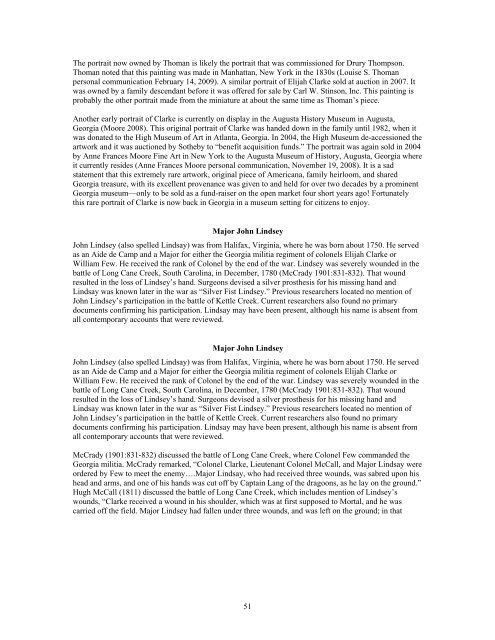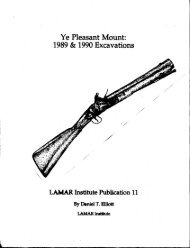Stirring Up a Hornet's Nest: - UGA Laboratory of Archaeology ...
Stirring Up a Hornet's Nest: - UGA Laboratory of Archaeology ...
Stirring Up a Hornet's Nest: - UGA Laboratory of Archaeology ...
Create successful ePaper yourself
Turn your PDF publications into a flip-book with our unique Google optimized e-Paper software.
The portrait now owned by Thoman is likely the portrait that was commissioned for Drury Thompson.<br />
Thoman noted that this painting was made in Manhattan, New York in the 1830s (Louise S. Thoman<br />
personal communication February 14, 2009). A similar portrait <strong>of</strong> Elijah Clarke sold at auction in 2007. It<br />
was owned by a family descendant before it was <strong>of</strong>fered for sale by Carl W. Stinson, Inc. This painting is<br />
probably the other portrait made from the miniature at about the same time as Thoman’s piece.<br />
Another early portrait <strong>of</strong> Clarke is currently on display in the Augusta History Museum in Augusta,<br />
Georgia (Moore 2008). This original portrait <strong>of</strong> Clarke was handed down in the family until 1982, when it<br />
was donated to the High Museum <strong>of</strong> Art in Atlanta, Georgia. In 2004, the High Museum de-accessioned the<br />
artwork and it was auctioned by Sotheby to “benefit acquisition funds.” The portrait was again sold in 2004<br />
by Anne Frances Moore Fine Art in New York to the Augusta Museum <strong>of</strong> History, Augusta, Georgia where<br />
it currently resides (Anne Frances Moore personal communication, November 19, 2008). It is a sad<br />
statement that this extremely rare artwork, original piece <strong>of</strong> Americana, family heirloom, and shared<br />
Georgia treasure, with its excellent provenance was given to and held for over two decades by a prominent<br />
Georgia museum—only to be sold as a fund-raiser on the open market four short years ago! Fortunately<br />
this rare portrait <strong>of</strong> Clarke is now back in Georgia in a museum setting for citizens to enjoy.<br />
BMajor John Lindsey<br />
John Lindsey (also spelled Lindsay) was from Halifax, Virginia, where he was born about 1750. He served<br />
as an Aide de Camp and a Major for either the Georgia militia regiment <strong>of</strong> colonels Elijah Clarke or<br />
William Few. He received the rank <strong>of</strong> Colonel by the end <strong>of</strong> the war. Lindsey was severely wounded in the<br />
battle <strong>of</strong> Long Cane Creek, South Carolina, in December, 1780 (McCrady 1901:831-832). That wound<br />
resulted in the loss <strong>of</strong> Lindsey’s hand. Surgeons devised a silver prosthesis for his missing hand and<br />
Lindsay was known later in the war as “Silver Fist Lindsey.” Previous researchers located no mention <strong>of</strong><br />
John Lindsey’s participation in the battle <strong>of</strong> Kettle Creek. Current researchers also found no primary<br />
documents confirming his participation. Lindsay may have been present, although his name is absent from<br />
all contemporary accounts that were reviewed.<br />
BMajor John Lindsey<br />
John Lindsey (also spelled Lindsay) was from Halifax, Virginia, where he was born about 1750. He served<br />
as an Aide de Camp and a Major for either the Georgia militia regiment <strong>of</strong> colonels Elijah Clarke or<br />
William Few. He received the rank <strong>of</strong> Colonel by the end <strong>of</strong> the war. Lindsey was severely wounded in the<br />
battle <strong>of</strong> Long Cane Creek, South Carolina, in December, 1780 (McCrady 1901:831-832). That wound<br />
resulted in the loss <strong>of</strong> Lindsey’s hand. Surgeons devised a silver prosthesis for his missing hand and<br />
Lindsay was known later in the war as “Silver Fist Lindsey.” Previous researchers located no mention <strong>of</strong><br />
John Lindsey’s participation in the battle <strong>of</strong> Kettle Creek. Current researchers also found no primary<br />
documents confirming his participation. Lindsay may have been present, although his name is absent from<br />
all contemporary accounts that were reviewed.<br />
McCrady (1901:831-832) discussed the battle <strong>of</strong> Long Cane Creek, where Colonel Few commanded the<br />
Georgia militia. McCrady remarked, “Colonel Clarke, Lieutenant Colonel McCall, and Major Lindsay were<br />
ordered by Few to meet the enemy….Major Lindsay, who had received three wounds, was sabred upon his<br />
head and arms, and one <strong>of</strong> his hands was cut <strong>of</strong>f by Captain Lang <strong>of</strong> the dragoons, as he lay on the ground.”<br />
Hugh McCall (1811) discussed the battle <strong>of</strong> Long Cane Creek, which includes mention <strong>of</strong> Lindsey’s<br />
wounds, “Clarke received a wound in his shoulder, which was at first supposed to Mortal, and he was<br />
carried <strong>of</strong>f the field. Major Lindsey had fallen under three wounds, and was left on the ground; in that<br />
51










